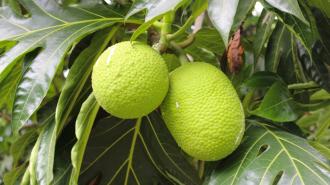Since reaching a low point in 2015, the number of people lacking regular access to nutritious food has been rising worldwide. The problem has been exacerbated by factors including the ongoing repercussions of the COVID-19 pandemic, as well as Russia’s invasion of Ukraine – but underlying the threat to global food security is the looming transformation of Earth’s climate.
Nowhere will these changes be more stark than in the tropics, where rising temperatures are already increasing the frequency and intensity of droughts, storms, floods, and fires. These mounting challenges mean that the areas suitable for growing many staple crops, including wheat, rice, corn, and soybeans, will become increasingly sparse towards the end of the century – diminishing a key input for both the availability and diversity of nutritious food.
The breadfruit is high in fibre, rich in key vitamins and minerals, and known for its culinary versatility.
If we are to adapt to these new circumstances, we will need to bolster the resilience of global food production as quickly as possible. Strategies for achieving this goal will certainly require transformations in the way we produce and consume food.
In part, however, they could also involve looking more closely at food resources that are already available, but have so far gone under the radar.
A climate-resilient crop: According to one team at Northwestern University, part of the solution to the world’s food crisis could lie with the humble breadfruit.
A relative of the jackfruit, native to the Pacific Islands, this starchy fruit is both high in fibre, and rich in key vitamins and minerals. It is also known for its culinary versatility: similarly to the potato, it can be steamed, roasted, fried, fermented, or ground into flour to increase its shelf life.
These benefits have made breadfruit an important part of cultural life throughout Oceania for thousands of years. The crop has also been introduced to South and Central America, the Caribbean, and tropical regions in Asia. Even so, it still isn’t widely used as a staple crop outside of its native Pacific.
Breadfruit trees are able to withstand 3 to 4 months of drought.
While its cultivation could easily be expanded elsewhere, uncertainty about the future means that farmers are understandably reluctant to choose breadfruit over more traditional crops. Yet in their study, Lucy Wang and her Northwestern colleagues identified several traits of the breadfruit that could actually make it far more resilient against climate change than other crops.
Perhaps most vitally, breadfruit trees produce fruit for over 50 years without being replaced. This allows the crops to spread their roots deeper into the soil, and establish relationships with native species of plants, animals, fungi, and microbes, making them more resilient against unpredictable conditions.
Whereas traditional annual crops can be wiped out by prolonged extreme weather, Yang’s team found that breadfruit trees are able to withstand 3 to 4 months of drought.
Simulating resilience: In their study, Yang’s team explored whether a more widespread cultivation of breadfruit in the tropics could help to boost global food security in the face of a changing climate.
The researchers used an ensemble of global climate models to simulate several aspects of the Earth’s climate between the years 2061 and 2080, including temperature, precipitation, and their variations throughout the year.
They also accounted for two possible futures for global emissions of greenhouse gasses: one where they keep on rising; and another more likely scenario, where emissions stabilize towards the middle of the century.
The models show that breadfruit presents a sustainable, climate-resilient alternative to other staple crops.
The team’s results were surprisingly encouraging. In the more likely emissions scenario, their models predicted that areas suitable for growing breadfruit will only decrease by around 4.4% worldwide – but even in the worst-case scenario, this area only diminished by around 4.5%.
These changes weren’t even across the globe: while suitable regions actually expanded in Southeast Asia and the Pacific, they contracted by up to 11.5% in Latin America and the Caribbean.
All the same, the quality and consistency of crop yields showed very little difference between both scenarios.
Improving food security: For Yang and her colleagues, the models clearly show that breadfruit presents a sustainable, climate-resilient alternative to other staple crops – with yields less vulnerable to extreme and uncertain weather conditions.
The team hopes their results could encourage farmers in tropical regions to grow breadfruit alongside their other crops – with added benefits including improvements in crop diversity, increased water efficiency, and a reduced reliance on chemical fertilizers.
Because the fruit is seedless, there is also no risk of the tree becoming invasive when planted in new environments. Even further, farmers could continue to use traditional techniques to grow and harvest breadfruit, both boosting local communities, and helping them to conserve biodiversity in vital tropical ecosystems.
By expanding the cultivation of breadfruit in the tropics, particularly in sub-Saharan Africa, where the crop is still rarely grown, Yang’s team ultimately hope that the versatile crop could be at least a partial solution to the growing global food crisis — potentially securing a reliable source of nutrients for billions of people in the uncertain decades to come.
We’d love to hear from you! If you have a comment about this article or if you have a tip for a future Freethink story, please email us at [email protected].






